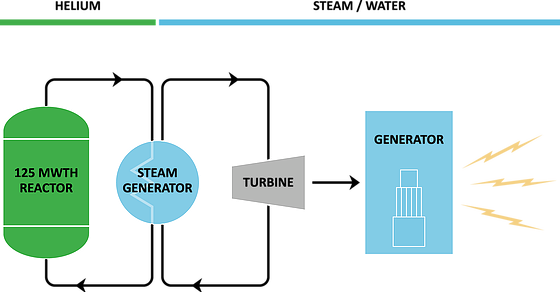Startup X-energy has started design of a gas-cooled pebble bed modular nuclear reactor
by noreply@blogger.com (brian wang) from NextBigFuture.com on (#2G7WV)
X-energy yesterday announced the start of work on the conceptual design of its Xe-100 high temperature gas-cooled pebble bed modular reactor, following a review of the company's readiness by an external panel of industry experts.
Maryland-based Xenergy's has a panel of industry experts from Southern Nuclear, Burns and McDonnell and Technology Insights. The conceptual design readiness review validated the baseline design parameters, preparatory documentation, analysis tools, scope of the proposed conceptual design phase (including all planned deliverables), management processes and overall team readiness to proceed to the next phase of reactor development.



X-energy plans to deploy the Xe-100 within 10 years, and CEO Kam Ghaffarian said moving the reactor into conceptual design put the company "well on the way" towards its goal. "A successful conceptual design phase requires thorough planning, a mature technical baseline, and a workforce committed to creating a safe, deployable design. I and our external review panel confirmed our readiness on March 8," he said.
US research into high-temperature gas-cooled reactors (HTGRs) began in the 1940s at Oak Ridge National Laboratory (ORNL), and X-energy's reactor design builds on earlier Department of Energy (DOE) studies. Demonstration HTGR plants of various designs have operated in Germany, the UK and the USA, and two are currently operable - Japan's HTTR, and China's China's HTR-10.
The Xe-100 is a 200 MWt (75 MWe) reactor, which X-energy envisages being built as a standard "four-pack" plant generating about 300 MWe. The plant will use 'pebbles' of fuel containing Triso (tristructural-isotropic) fuel particles. Each Triso particle has a kernel of uranium oxycarbide (uranium dioxide) enriched to 10% uranium-235, encased in carbon and ceramic layers. About 25,000 Triso particles, each about 0.4 millimetres in diameter, are embedded in graphite to produce spherical fuel pebbles. About 17,000 pebbles will be used in each reactor.
Triso fuel's carbon and ceramic layers prevent the release of radioactivity, providing each particle with its own independent containment system, while the graphite surrounding the particles moderates the nuclear reaction. Such fuel cannot melt down and X-energy describes the reactor as "walk-away" safe in the event of a loss of coolant.
All of the plant's components will be road-transportable, streamlining construction by enabling the plant to be installed, rather than constructed, at the project site.
In January, X-energy was awarded cost-shared funding of $53 million over five years from the DOE to support the development of the Xe-100, working in partnership with BWX Technology, Oregon State University, Teledyne-Brown Engineering, SGL Group, Idaho National Laboratory and ORNL. At the same time, the DOE selected Southern Company Services, a subsidiary of Southern Company, to receive similar funding to develop its Molten Chloride Fast Reactor in partnership with TerraPower, Electric Power Research Institute, Vanderbilt University, and ORNL. In August last year, X-energy and Southern Nuclear Operating Company signed a memorandum of understanding to collaborate on development and commercialisation of their respective advanced reactor designs.
Read more










Maryland-based Xenergy's has a panel of industry experts from Southern Nuclear, Burns and McDonnell and Technology Insights. The conceptual design readiness review validated the baseline design parameters, preparatory documentation, analysis tools, scope of the proposed conceptual design phase (including all planned deliverables), management processes and overall team readiness to proceed to the next phase of reactor development.



X-energy plans to deploy the Xe-100 within 10 years, and CEO Kam Ghaffarian said moving the reactor into conceptual design put the company "well on the way" towards its goal. "A successful conceptual design phase requires thorough planning, a mature technical baseline, and a workforce committed to creating a safe, deployable design. I and our external review panel confirmed our readiness on March 8," he said.
US research into high-temperature gas-cooled reactors (HTGRs) began in the 1940s at Oak Ridge National Laboratory (ORNL), and X-energy's reactor design builds on earlier Department of Energy (DOE) studies. Demonstration HTGR plants of various designs have operated in Germany, the UK and the USA, and two are currently operable - Japan's HTTR, and China's China's HTR-10.
The Xe-100 is a 200 MWt (75 MWe) reactor, which X-energy envisages being built as a standard "four-pack" plant generating about 300 MWe. The plant will use 'pebbles' of fuel containing Triso (tristructural-isotropic) fuel particles. Each Triso particle has a kernel of uranium oxycarbide (uranium dioxide) enriched to 10% uranium-235, encased in carbon and ceramic layers. About 25,000 Triso particles, each about 0.4 millimetres in diameter, are embedded in graphite to produce spherical fuel pebbles. About 17,000 pebbles will be used in each reactor.
Triso fuel's carbon and ceramic layers prevent the release of radioactivity, providing each particle with its own independent containment system, while the graphite surrounding the particles moderates the nuclear reaction. Such fuel cannot melt down and X-energy describes the reactor as "walk-away" safe in the event of a loss of coolant.
All of the plant's components will be road-transportable, streamlining construction by enabling the plant to be installed, rather than constructed, at the project site.
In January, X-energy was awarded cost-shared funding of $53 million over five years from the DOE to support the development of the Xe-100, working in partnership with BWX Technology, Oregon State University, Teledyne-Brown Engineering, SGL Group, Idaho National Laboratory and ORNL. At the same time, the DOE selected Southern Company Services, a subsidiary of Southern Company, to receive similar funding to develop its Molten Chloride Fast Reactor in partnership with TerraPower, Electric Power Research Institute, Vanderbilt University, and ORNL. In August last year, X-energy and Southern Nuclear Operating Company signed a memorandum of understanding to collaborate on development and commercialisation of their respective advanced reactor designs.
Read more